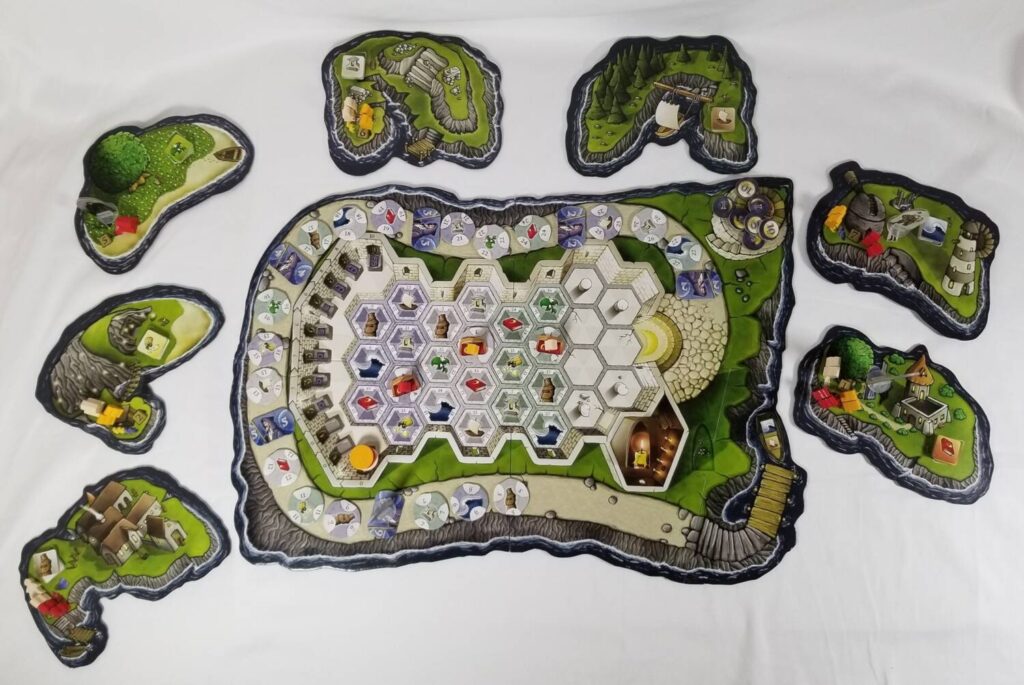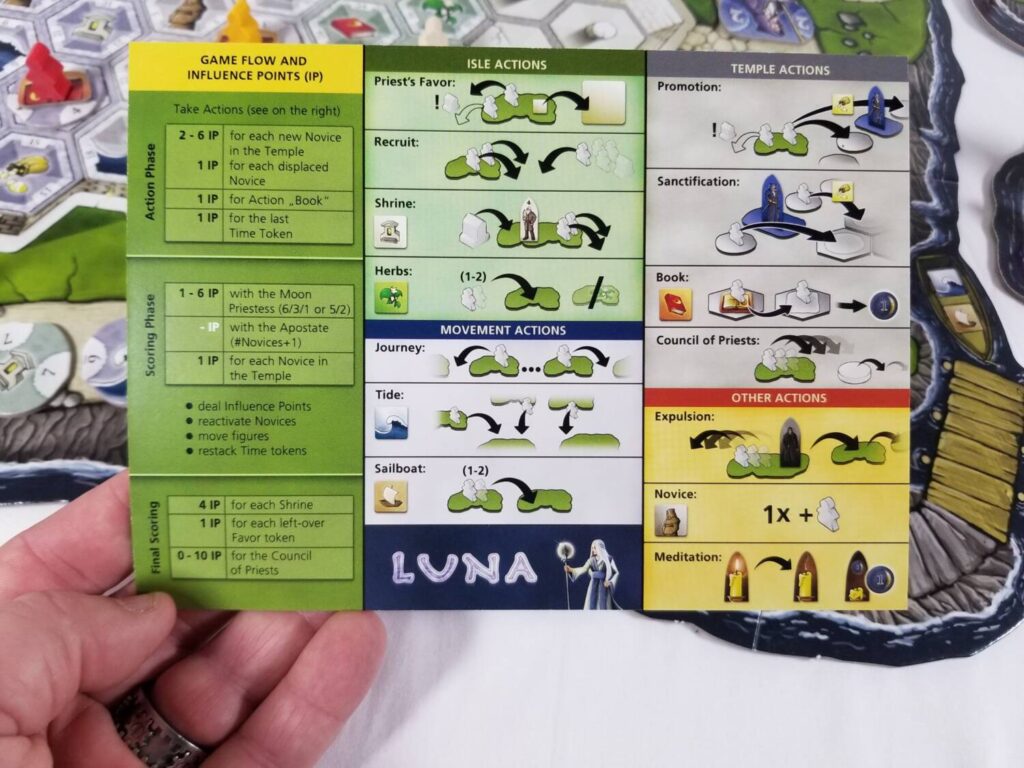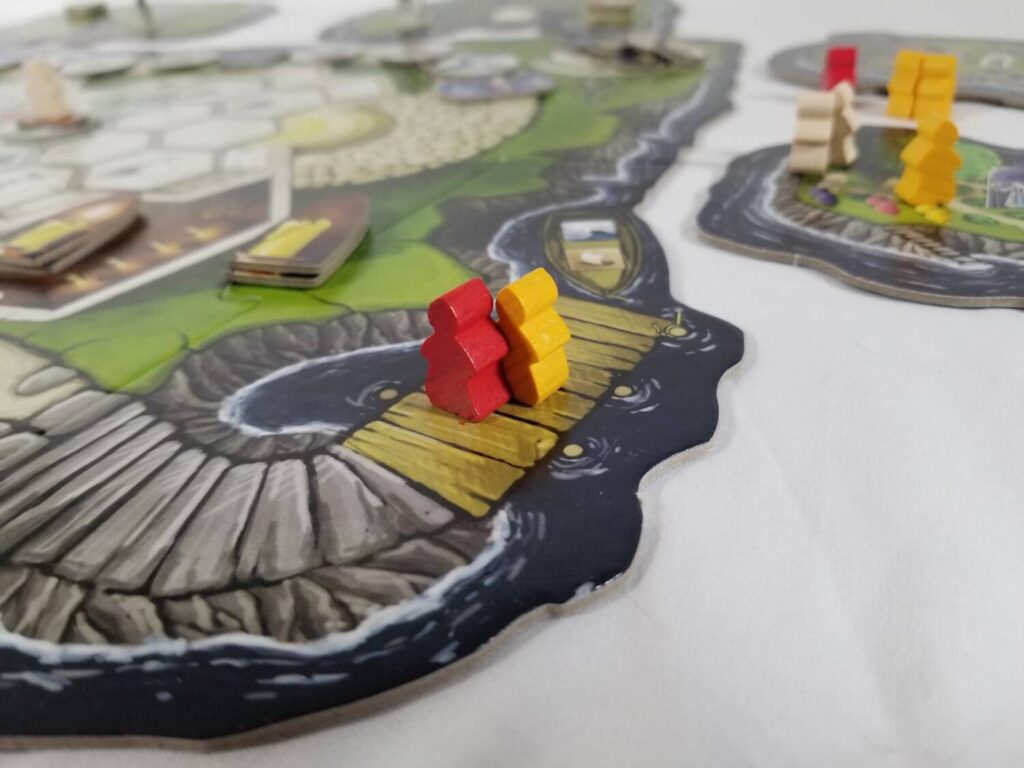Hello and welcome to ‘Focused on Feld’. In my Focused on Feld series of reviews, I am working my way through Stefan Feld’s entire catalogue. Over the years, I have hunted down and collected every title he has ever put out. Needless to say, I’m a fan of his work. I’m such a fan, in fact, that when I noticed there were no active Stefan Feld fan groups on Facebook, I created one of my own.
Today we’re going to talk about 2010’s Luna, his 10th game.
2010 was another banner year for Stefan Feld. That was the year Luna (the subject of this review) and The Speicherstadt were introduced to the world, bookended by the relatively obscure games Spiel mit Lukas: Dribbel-Fieber and It Happens! That’s four games in a single year, a feat which he has only ever reproduced twice: in 2013 and 2022. With at least 3 titles slated for this year (that I am aware of at the time of this writing), maybe 2024 will be the year he’ll strike again. Who knows? All I know is that I’m excited to find out.
Of Temples and Sects (I Think?)
In Luna, players take on the roles of leaders of various sects of worshippers of the titular goddess, Luna. Throughout the course of the game, they’ll be making voyages to the Holy isles and performing tasks to curry her favor, occasionally sending novices to the central temple to curry more favor? I think?
Okay, hear me out. Not every game needs a theme or a backstory. But if you do choose to go with a backstory, it’s helpful to have it make some kind of sense. Luna’s backstory isn’t really fleshed out or described in any kind of detail. The few details there are can be gleaned through three tiny snippets of what are presumably journal entries of one of the aforementioned novices.
But, I digress. To recap: there are islands. There are novices. There’s a temple. There are different sects (i.e. player colors). Over the course of a game of Luna, you will be using your novices to perform actions at the different outer islands in an effort to eventually send those same said novices to the Temple board where they will score you points.
There are essentially two different styles of games going on at the same time. The outer islands present a sort of race wherein the goal is simply to get to the Temple board before your opponents. The Temple board presents an entirely different challenge. Once you’re on the Temple board, Luna becomes a kind of area control game wherein the players will be jockeying for position in an attempt to score points and banish the other players’ novices to prevent them from doing the same.
Of course, this is just a high-level overview of the game. If you’ve read enough and just want to know what I think, feel free to skip ahead to the Thoughts section. Otherwise, read on as we learn how to play Luna.
Setup
A game of Luna is setup thusly:

The Temple board frame is constructed and placed into the center of the playing area. This frame will be populated with a number of Temple board segments dependent on player count. This may result in some Temple board segments being placed face down within the frame.
Surrounding the Temple board are the seven Holy isles. These are arranged in numerical order in a clockwise direction. Note: there is an optional advanced setup using the opposite side of these tiles that features more randomness in their placement and more player choice during starting setup. For the purposes of this review, though, we’ll be going with the standard setup.
Next, the Temple tiles are separated by color. Any not matching the color of the face up Temple board segments are removed from the game. From the remaining Temple tiles, randomly distribute any of the tiles numbered between 1 and 4 that are left between the players. The players place the received tiles into the matching spots in the Temple along with one of their novices and a Book of Wisdom token. The remaining Temple tiles are arranged along the path, beginning at the Temple gate, in descending order, interspersed with Guard tiles, which are arranged in ascending order.
Then, place the Guard of the Temple standee on the #6 Guard tile and the other standees on their marked positions on the Holy Isles. There are also marked positions for all of the starting player pieces—eight novices and one shrine each. The Time tokens are arranged in numerical order and placed into their starting position on the Temple board.
Choose a start player and give them the Start player marker. Players receive their remaining pieces, along with a few Influence point (i.e. – victory point) tokens. From those remaining pieces, they will place their Member of the Council piece into the 0 spot of the Council of Priests, on the Temple board, in turn order (the first player’s piece will be on the bottom of the stack).
Now you’re ready to begin playing Luna.
Pilgrimage
A round of Luna, of which there are six, is broken down into two phases: an action phase and a scoring phase. In the action phase, players will take turns taking an action until all of the Time tokens have been turned over (more on this later). In the scoring phase, players will receive and/or lose points based on where their novices are on the outer islands and within the temple itself.

Each of the seven Holy Isles provides a specific type of Favor token. Each of these tokens is used when performing specific actions. During a game, a player may only ever possess a single copy of any given Favor token. So, with that understanding, here are the actions you can perform, in brief:
– move two novices off of an island to the waters surrounding it, to signify they’ve worked (I will refer to this using the term ‘exhaust’ from this point forward), to gain a copy of that island’s token.
– exhaust two novices to gain a novice from your supply and add it to the exhausted novices
– exhaust novices to build shrines (one per player, per island)
– return an Herbal Favor token to un-exhaust novices
– move active novices to different Isles and exhaust them (thereby setting yourself up for future turns)
– return Tidal Favor tokens to move both inactive and active novices from anywhere and move them anywhere else, exhausting them
– exhaust novices to claim Temple tiles
– move claimed Temple tiles into the temple
– protect your novices within the temple from displacement by using Book of Wisdom tokens
– move up in the Council of Priests
– expel the Apostate standee (who will cost you points during scoring) to another Holy Isle
– pass your turn, thus turning over a Time token
That’s a lot of actions to remember, but there’s a handy Player aid provided that outlines them all. Thankfully, they’re all fairly easy to remember as none of the mechanics surrounding any singular action are particularly complicated.
Arrival
The Temple board is divided into three distinct areas: the path, the temple proper, and the Council of Priests. With the exception of the novices placed into the temple during setup, every novice’s journey begins on the path.
To send a Novice to the temple path, the player chooses two novices on a Holy Isle, exhausts them, and assigns one of them to a matching Temple tile on the path, with one caveat: a novice can only be assigned to a Temple tile that is on the path ahead of the Guard. To place a novice on a temple tile beyond the Guard, they would need to use a Bribe token (collected from one of the Holy Isles).

Once you’ve got at least one novice assigned to a Temple tile, you’re in a position to move your novice into the temple proper. If it’s sitting on a tile ahead of the Guard, you’ll simply move the tile and the novice to the matching space in the temple. If it’s sitting on a tile beyond the Guard (meaning you used a Bribery token to set it there in the first place), you’ll need to use a Bribery token to move it into the temple. You’ll earn points for moving your novice into the temple.
Once placed, there’s a chance your novice may displace your opponents’ novices if those novices are on a Temple tile bearing a number lower than the one you placed, and if they are not protected with a Book of Wisdom token. You earn points for displacing novices in this way. The expelled novice is not sent back to its owner. Instead, it’s left sitting on a dock where it cannot be moved without the use of a Boat or a Tidal Favor tile.
The last action you may perform in the temple is to gain influence in the Council of Priests. For every novice exhausted from a single Holy Isle, you’ll be able to move your Member of the Council up one level.
The Full-Bodied Flavor of Curried Favor
I already discussed how moving a novice into the temple and expelling other novices will earn you points. But, since this is a Feld game, there are plenty of opportunities to score points elsewhere.
Each time you add a Book of Wisdom token to a novice, you score a point. You can score points if you end the round on the Holy Isle with the Luna standee. You lose points for having novices on the Holy Isle with the apostate. Each of your novices that are still in the temple at the end of a round earn you a point.

At the end of the game, you’ll earn points for each shrine you’ve built. Every leftover Favor token will net you a point. And, you’ll earn points based on your position within the Council of Priests (which also serves as the tie breaker).
The rulebook states: “The player with the most influence points wins the game – his Order will provide the next Moon Priestess.” I find it odd that this important story element wasn’t included at the front of the rule book, but whatever. Or maybe it was? Who knows. Like I said earlier, the story here is nonsensical.
Thoughts
My quibbles about the story elements aside, I quite like Luna. For starters, it’s a good looking game. Klemens Franz’s inestimable talent is on full display. And, while it may look a little awkward once it’s been set up on the table, Luna’s actually got some very good production value. The version I own is the H@ll Games original, which is great, but if you’re lucky enough to get your hands on the Deluxified version from 2018, it’s a thing of beauty.
More important is the gameplay itself. Luna forces you to make a lot of interesting decisions, and it forces you to make them often. For instance, consider the act of sending a novice to the Temple board.
The Temple board is where a large portion of your points are going to come from whether it be from displacing others’ novices, adding Book of Wisdom tokens to your own novices, or from novices that have been moved into the temple proper and remaining there during scoring. So, getting novices onto the Temple board is of utmost importance. But, it comes at a cost. Each novice sent to the Temple board is one less novice performing work on the Holy Isles, and you need them to work because they provide you with the tokens you need to send novices to the Temple board in the first place.
The temptation at the beginning of the game might be to just spend the first few rounds building up your novice workforce. That isn’t such a bad idea. The larger your workforce, the more options you have. The downside is that, while you’re building up a workforce, your opponents are going to be scoring points in the temple. Do you risk it? Do you give up the points now for more actions later? Or, do you try to strike some kind of balance?
And consider the tiles on the Temple path. The higher numbered tiles are behind Guards. If you want to claim those early, you’ll need Bribe tokens. Then, you’ll need a second Bribe token to place them into the temple. Or, you could hold off on putting them into the temple for a while and place them in there when there’s more opportunity to expel other players’ novices. However, if you’re sitting on a high numbered tile, chances are your opponents are going to make their choices with that knowledge in mind, gathering Book of Wisdom tokens to protect themselves and claiming Temple tiles that do not border the tile you’re ready to pounce with. So, do you wait and chance your opponents actively working to downplay the effectiveness of the tile, or do you place it out as soon as you can so that you can begin earning points with it right away?

Luna is fraught with these kinds of decisions. You’ll constantly find yourself weighing the risks and the rewards of every little thing you do. The only easy decision is what to do with that one lone novice that’s sitting on a Holy Isle all by themselves. If there’s not a shrine, then moving up in the Council of Priests is your best bet.
Luna’s a fabulous game that’s brought me a lot of joy over the years. While it isn’t one of Feld’s most celebrated designs, it’s still one of his strongest. In fact, I misspoke when I said there was only one easy decision. There are actually two.
When it comes to deciding whether or not you should play Luna, the decision is always a resounding ‘yes’.
If you’d like to try Luna for yourself, it’s free to play on Yucata. Go give it a try. You’ll thank me.











Add Comment